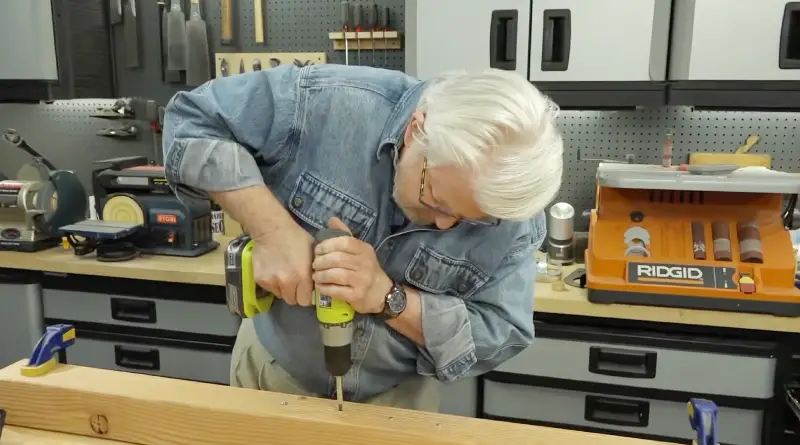How to Get Out a Stripped Screw | Try One of These Effective Ways
TheToolGeeks.com is a participant in the Amazon Services LLC Associates Program and other affiliate advertising programs. We may earn from qualifying purchases. (Learn More).
Dealing with a stripped screw is tough for any DIY enthusiast or professional. Whether the screw is corroded, over-tightened, or has just worn out over time, you’ll have trouble getting it out. But don’t worry, from using rubber bands to specialized extraction tools, there are several methods you can try.
For small screws, the use of rubber bands or duct tape will provide additional grip and traction. Abrasive powder or sand can be used to increase friction and traction when turning a stripped screw. Drilling the center of the screw head or welding a nut can help loosen and remove stubborn, stripped screws.
As part of this article, we’ll explore the top 10 techniques that you can use to remove a stripped screw. By the end of this article, you’ll have a solid grasp on tackling such projects confidently.
How to Get Out a Stripped Screw: 10 Effective Ways
Having trouble removing a stripped screw? Here are 10 effective yet simple techniques to simplify the process and save you time to get it out.
- Apply rubber band
- Use duct tape over the screw head
- Pour in some abrasive powder
- Add steel wool to the head
- Try using a different screwdriver
- Use a pair of pliers
- Use a rotary tool with a cut-off blade
- Apply some anti-slip gel
- Using stripped screw extractor kit
- Weld a nut to the screw’s head
1. Apply Rubber Band
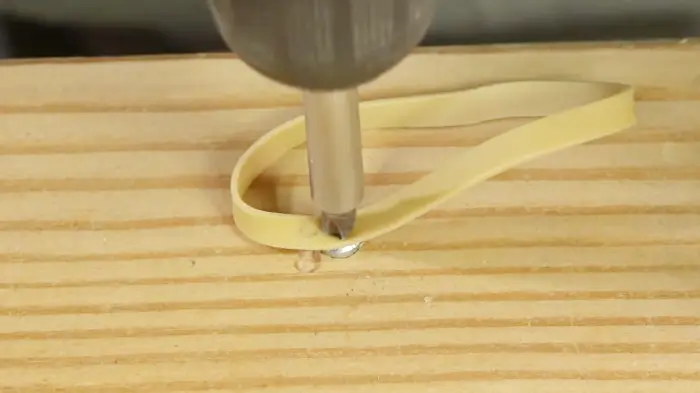
You can effectively remove a stripped screw by placing a rubber band on top of the stripped screw head. Simply pressing the rubber band firmly with the screwdriver tip while turning counterclockwise with consistent downward pressure.
The rubber band provides additional grip and traction, allowing the screwdriver to catch and turn the stripped screw. Ensure the rubber band is wide enough to cover the entire screw head and thick enough to create friction.
As you apply pressure and turn the screwdriver, the rubber band molds to the shape of the screw head, increasing the chances of successful extraction. This method is particularly useful for small or stubborn stripped screws, providing an inexpensive and simple solution to a common problem.
Note: Use a new rubber band to ensure optimal grip and effectiveness.
2. Use Duct Tape Over the Screw Head
Consider using duct tape over the screw head to provide added grip when attempting to remove a stripped screw. This method can help you get a better grip on the screw and increase your chances of successfully turning it counterclockwise with a screwdriver.
Place a piece of duct tape over the stripped screw, ensuring it adheres firmly to the head. Then, use the screwdriver to turn the screw counterclockwise. The duct tape can enhance the friction between the screw head and the screwdriver, making it easier to apply the necessary torque to remove the stripped screw.
3. Pour in Some Abrasive Powder
You can also create more traction by applying pressure to the screwhead with a drill bit after adding some abrasive powder or sand. Similar to the above methods, this approach aims to provide a better grip on the stripped screw, allowing you to twist it out.
Slowly turn the screw, ensuring that you have a good grip on it. This method can be effective in situations where other techniques have failed, providing a viable option for dealing with stubborn, stripped screws.
4. Add Steel Wool to the Head
If pouring abrasive powder onto the stripped screw didn’t work, consider adding a small section of steel wool to the head. To do this, tear off a coin-sized piece of steel wool, flatten it, and put it over the screw.
Then, insert the tip of the screw through the steel wool and turn it counterclockwise. The steel wool provides additional grip to help the screwdriver gain traction on the damaged screw head.
This method works well in loosening the stripped screw and allowing you to remove it without causing further damage. Be cautious and exert steady pressure to avoid breaking the screw or damaging the surrounding material.
5. Try Using a Different Screwdriver
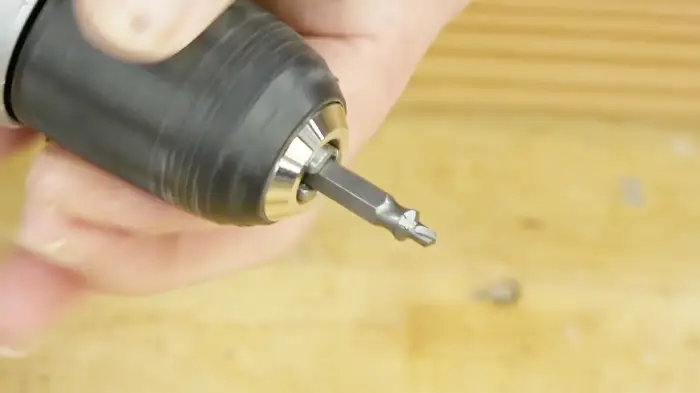
Consider trying a different size or style of screwdriver to improve your grip on the stripped screw and speed up its removal effectively.
If you’re dealing with a damaged Phillips head screw, you should use a screwdriver with a slightly wider bit. Apply steady pressure to ensure the screwdriver grabs the stripped head, then attempt to loosen it as usual.
Sometimes, a different style of screwdriver, such as a square or star head, can also provide better traction on a stubborn stripped screw. By experimenting with various screwdriver options, you can increase your chances of successfully removing the stripped screw without damage to the surrounding material.
Note: Use steady, controlled force to avoid further complicating the situation.
6. Use a Pair of Pliers (If Possible)
Try using a pair of locking pliers to grip the stripped screw tightly and prevent it from slipping as you attempt to remove it. This method is most effective when the screw head is accessible and protruding enough for the pliers to grab onto.
Locking pliers are particularly useful because they provide a stronger grip on the screw compared to regular pliers, minimizing the risk of slippage.
To use this technique, simply clamp the locking pliers onto the exposed part of the screw head and apply steady, even pressure while turning it counterclockwise. This should help to dislodge the stripped screw and facilitate its removal.
Warning: Assess the accessibility and condition of the screw head before attempting this method.
7. Use a Rotary Tool with a Cut-off Blade
To extricate a stripped screw, cut a slot across the damaged screw head with a rotary cutter with a cut-off blade. Then, insert a flat-blade screwdriver and turn it counterclockwise to back it out.
This method is effective for screws with severely damaged heads, as the slot provides a new surface for the screwdriver to grip onto. When using the power tool, ensure the slot is wide enough for the screwdriver to fit securely. Care to align the slot properly to prevent damage to the surrounding surface.
Once the slot is cut and the screwdriver is inserted, apply steady pressure while turning counterclockwise to unscrew the stripped screw. This method can be particularly useful for stubborn or rusted screws.
8. Apply Some Anti-Slip Gel
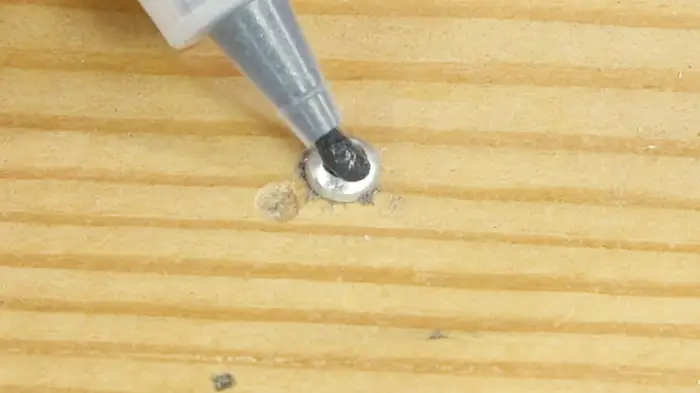
Applying an anti-slip gel to a stripped screw can enhance the grip between the screw and the screwdriver, aiding in its removal. The fluid contains crystals suspended in a specialized liquid, increasing friction and improving grip.
To use it effectively, apply the fluid (such as Solder-It or Screw Grab) directly onto the stripped screw and let it penetrate the threads. Next, insert the screwdriver and apply steady downward pressure while turning it counterclockwise.
The enhanced grip provided by the fluid helps to prevent the screwdriver from slipping out of the stripped screw, making it easier to remove.
Note: Use only a small amount (like one drop) of the fluid, as a little goes a long way in improving the grip and facilitating the extraction of the stripped screw.
9. Using Stripped Screw Extractor Kit
A stripped screw extractor kit (like RWYMQWT stripped screw extractor) is a specialized tool that helps facilitate the extraction process. This works by improving the grip between the screwdriver and the stripped screw.
These kits are specifically designed for screw removal and come with bits that have two ends, one for burnishing and the other for extraction.
To use the kit, set the drill to reverse and use the burnishing end first to create a depression in the stripped screw. Then, flip the bit for extraction and run the drill in reverse with steady pressure.
This process allows the extractor bit to grip into the depression and twist the screw out. These extractor kits provide a reliable method for dealing with any stubborn stripped screws.
10. Weld a Nut to the Screw’s Head
If all the previous methods fail, consider spot-welding a nut to the top of the screw head as an effective method for extracting a stripped screw.
To do this, place a slightly bigger nut over the stripped screw and use a welder to fuse the nut to the screw head. Allow time for the welded nut and screw to cool before attempting to remove them.
Once the nut is securely welded to the screw, use a socket wrench to turn and extract the screw from the material. The heat from the welding process can also help break any corrosion or adhesives that may be holding the screw in place.
This method provides a strong grip on the screw, allowing for successful extraction without causing further damage to the surrounding material.
Can I drill out a stripped screw?
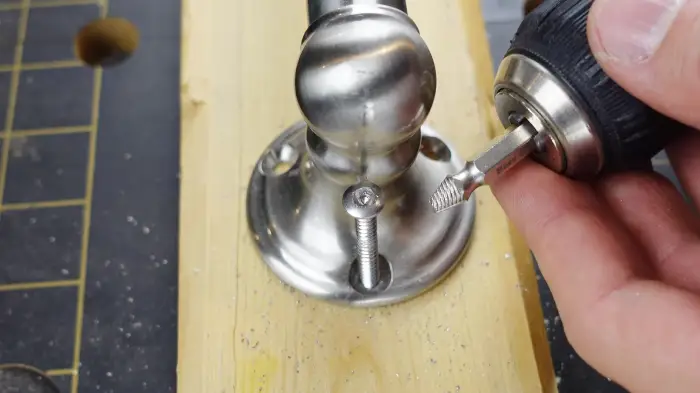
You can remove a stripped screw by slowly drilling out the center. Use a drill bit to gently create a hole in the center of the stripped screw. If the screw is soft enough to strip, it will be pliable enough for the drill bit to penetrate. It is not necessary to drill too deeply, just enough to remove the stripped screw head.
Once the center of the screw head has been removed, you can use a screw extractor tool to grip the remaining screw and twist it out. Remember to work patiently and carefully to avoid damaging the surrounding surface.
What oil can I spray on a stripped screw to loosen it?
You can enhance the chances of removing a stripped screw by applying penetrating oil and allowing it to set before firmly inserting your screwdriver and twisting.
Penetrating oils such as PB Blaster or Liquid Wrench are effective options for loosening a stubborn screw. By seeping into the small spaces between the screw threads and the material, these oils break the bond of corrosion or rust that may be causing it to get stuck.
Before applying the oil, clean the area around the screw to remove any dirt or debris that could hinder the penetration of the oil. Once the area is clean, generously spread penetrating oil on the screw and let it soak up for at least 10-15 minutes to seep in and dislodge the screw.
Does WD 40 loosen stripped screws during the removal process?
It is possible to loosen stripped screws with WD-40 during the removal process. WD-40 is a versatile product that can be used for various purposes, including loosening stubborn screws. Its lubricating properties help to penetrate the rust or debris that may be causing the screw to stick.
By spraying directly over the stripped screw and allowing it to penetrate for a few minutes, you can significantly ease the removal process. The lubricating properties will help to reduce friction, making it easier to turn the screw and remove it from the surface.
What should I do if the stripped screw is stuck due to glue?
When confronted with a stripped screw stuck due to glue, applying heat to the area using a hairdryer or a heat gun can help soften the glue. The heat causes the glue to become more malleable, allowing you to loosen the grip of the screw.
Begin by aiming the heating device at the stuck screw for a few minutes, spreading the heat equally. Ensure not to heat the area excessively, as too much heat can damage the surrounding materials.
After heating the screw, use a screwdriver or pliers to attempt to turn and remove it carefully. If the screw still doesn’t budge, repeat the heating process and try again.
You can also use a solvent specifically designed to dissolve the type of glue used. Apply the solvent as directed and let it soak into the stuck screw before attempting to remove it.
Can I use a left-handed drill bit to remove a stripped screw?
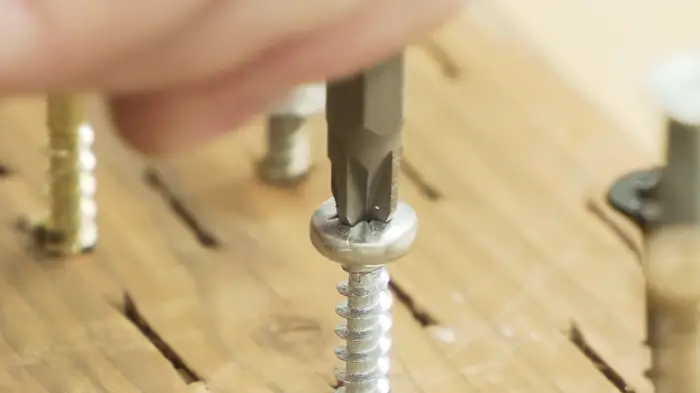
You can use left-handed drill bits to take advantage of turning counterclockwise, which can help catch onto the screw and extract it as they drill. This counterclockwise motion can create a reverse torque that may help to loosen the stripped screw.
When using a left-handed drill bit, start drilling at a slow speed to allow the bit to catch onto the screw. If it catches, the screw may start to back out as the drill continues to turn. However, if the left-handed drill bit doesn’t catch the screw, stop drilling immediately to avoid damaging the screw any further.
Simple Solutions for Removing Stripped Screws
Attempting to remove a stripped screw can not be possible without the proper method, but with the appropriate techniques and tools, it can be simple. From using a stripped screw extractor kit to welding a nut to the screw’s head, there are several ways to tackle this project.
Since not every solution may work in every scenario, it’s important to be patient and flexible. After all, being a DIY enthusiast means adapting to different situations and finding a solution that works for you.
So, the next time you come across a stripped screw, don’t panic, just pick one of the methods described above and get to work.
Amazon and the Amazon logo are trademarks of Amazon.com, Inc, or its affiliates.
